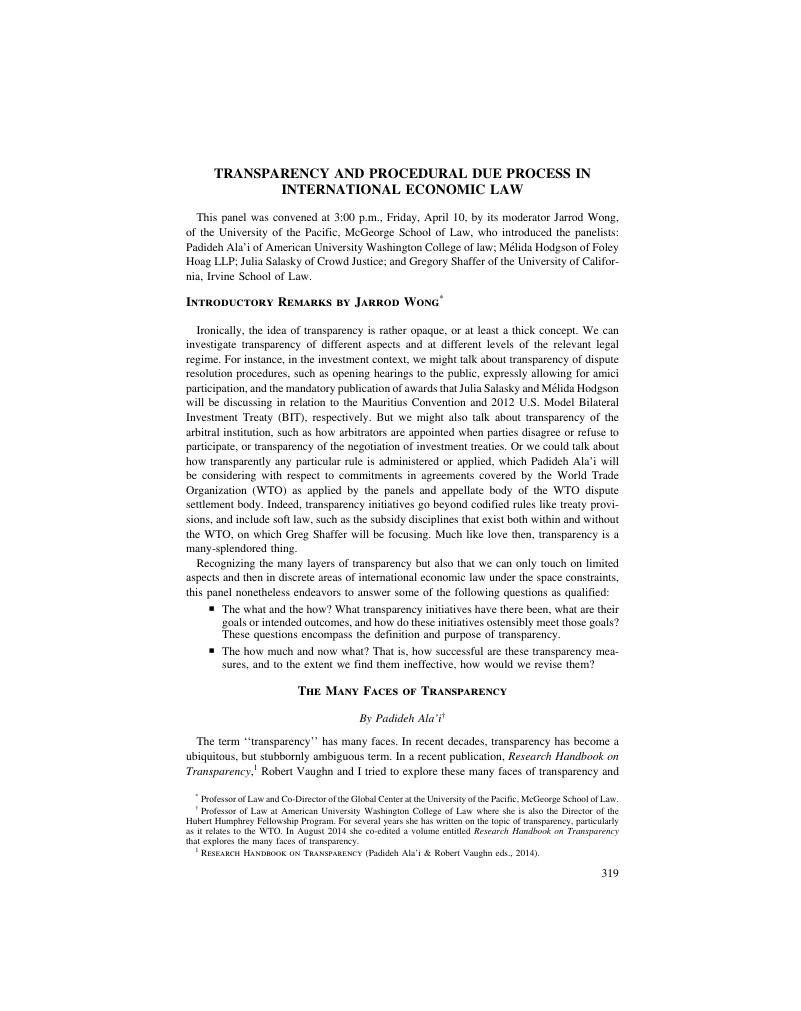No CrossRef data available.
Article contents
The Many Faces of Transparency
Published online by Cambridge University Press: 20 January 2017
Abstract

- Type
- Transparency and Procedural Due Process in International Economic Law
- Information
- Copyright
- Copyright © American Society of International Law 2016
References
1 Research Handbook on Transparency (Padideh Ala’i & Robert Vaughn eds., 2014).
2 See id. at 400-05 (for a more full discussion of the three perspectives).
3 See, e.g., Steger, Debra, The Future of the WTO: The Case for Institutional Reform, 12 J. Int’l Econ. L., 803, 833 (2009)Google Scholar; Charnovitz, Steve, Transparency and Participation in the World Trade Organization, 56 Rutgers L. Rev. 927, 960 (2005)Google Scholar.
4 Ala’i, Padideh, From the Periphery to the Centre? The Evolving WTO Jurisprudence on Transparency and Good Governance, 11 J. Int’l Econ. L., 779, 802 (2008)CrossRefGoogle Scholar.
5 Marrakesh Agreement Establishing the World Trade Organization, Apr. 15, 1994, 1867 U.N.T.S. 154 [hereinafter Marrakesh Agreement].
6 General Agreement on Tariffs and Trade, art. X, Oct. 30, 1947, 61 Stat. A-11, 55 U.N.T.S. 194.
7 International Convention Relating to the Simplification of Customs Formalities, arts. 4, 6, Nov. 3, 1923, 190 U.N.T.S. 253.
8 Marrakesh Agreement, supra note 5 at art. X:1.
9 Id., arts. X:2, X:3(a).
10 Id., art. X:3(b).
11 General Agreement on Trade in Services, arts. III, IV, Apr. 15, 1994, 1869 U.N.T.S. 183.
12 Agreement on Trade-Related Aspects of Intellectual Property Rights, art. 63, Apr. 15, 1994, 1869 U.N.T.S. 299.
13 Agreement on Implementation of Article VII of the General Agreement on Tariffs and Trade 1994, art. 12, Apr. 15, 1994, 1868 U.N.T.S. 279 (“Laws, regulations, judicial decisions and administrative rulings of general application giving effect to this Agreement shall be published in conformity with Article X of GATT 1994 by the country of importation concerned.”).
14 Agreement on Rules of Origin, arts. 2(f), 3(h), Apr. 15, 1994, 1868 U.N.T.S. 397 (providing that any administrative action taken in relation to the determination of origin “is reviewable promptly by judicial, arbitral or administrative tribunals or procedures, independent of the authority issuing the determination, which can affect the modification or reversal of the determination”).
15 Agreement on Safeguards, art 3., Apr. 15, 1994, 1869 U.N.T.S. 154 (allowing a member to apply for a safeguard measure “only following an investigation by the competent authorities of that Member pursuant to procedures previously established and made public in consonance with Article X of GATT 1994”).
16 Agreement on the Application of Sanitary and Phytosanitary Measures, art. 7, Apr. 15, 1994, 1867 U.N.T.S. 493 (“Members shall notify changes in their sanitary and Phytosanitary measures and shall provide information on their sanitary or Phytosanitary measures in accordance with the provisions of Annex B.”); Agreement on Technical Barriers to Trade, art. 2.9, Apr. 15, 1994, 1868 U.N.T.S. 120 (stating that a member shall notify other members through the secretariat of the products to be covered by the proposed technical regulation, together with a brief indication of its objective and rationale); and Agreement on Subsidies and Countervailing Measures, arts. 25, 26, Apr. 15, 1994, 1869 U.N.T.S. 14 (outlining the content, scope, and nature of notification that member states must provide regarding specific subsidies and the surveillance that the committee will conduct regarding new and full notifications).
17 Marrakesh Agreement, supra note 5 at Annex 3.
18 Appellate Body Report, United States – Restrictions on Imports of Cotton and Man-Made Fibre Underwear, 20, WT/DS24/AB/R (Feb. 25, 1997); Appellate Body Report, Thailand – Customs and Fiscal Measures on Cigarettes from the Philippines, WT/DS371/AB/R (June 17, 2011), ¶ 202.
19 See e.g. Appellate Body Report, United States – Import Prohibition of Certain Shrimp and Shrimp Products, WT/DS58/AB/R (Nov. 6, 1998), ¶¶ 181–82 (the Appellate Body held that where a WTO-inconsistent measure is justified as an exception under Article XX, the measure must nevertheless meet a high standard of transparency and due process to ensure that the restriction is not applied in an “arbitrary” or “discriminatory” manner, or as a “disguised restriction on international trade”).
20 Although as part of the TPRM the WTO members “recognize the inherent value of domestic transparency” and they “agree to encourage and promote greater transparency within their own systems” on a voluntary basis. See Marrakesh Agreement, supra note 5 at Annex 3, part B (Domestic Transparency).
21 For review of the cases, see Research Handbook on Transparency, supra note 2 at 373-78.
22 Panel Report, China Measures Related to the Exportation of Various Raw Materials, WT/DS398/R, WT/ DS395/R, WT/DS394/R (July 5, 2011), ¶ 7.636. See also Appellate Body Report, China – Measures Related to the Exportation of Various Raw Materials, WT/DS398/AB/R WT/DS395/AB/R, WT/DS394/AB/R (Jan. 30, 2012).


